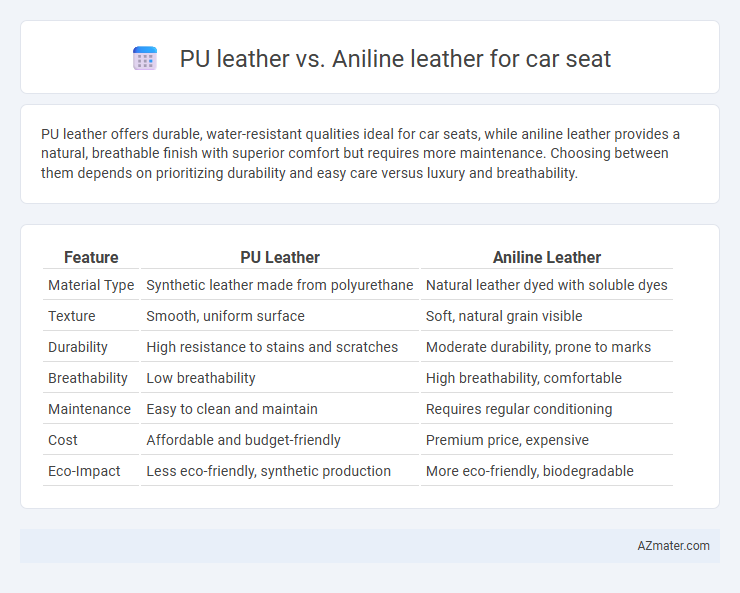PU leather offers durable, water-resistant qualities ideal for car seats, while aniline leather provides a natural, breathable finish with superior comfort but requires more maintenance. Choosing between them depends on prioritizing durability and easy care versus luxury and breathability.
Table of Comparison
| Feature | PU Leather | Aniline Leather |
|---|---|---|
| Material Type | Synthetic leather made from polyurethane | Natural leather dyed with soluble dyes |
| Texture | Smooth, uniform surface | Soft, natural grain visible |
| Durability | High resistance to stains and scratches | Moderate durability, prone to marks |
| Breathability | Low breathability | High breathability, comfortable |
| Maintenance | Easy to clean and maintain | Requires regular conditioning |
| Cost | Affordable and budget-friendly | Premium price, expensive |
| Eco-Impact | Less eco-friendly, synthetic production | More eco-friendly, biodegradable |
Introduction: Understanding PU Leather vs Aniline Leather
PU leather, a synthetic material made by coating a fabric base with polyurethane, offers durability, water resistance, and affordability for car seats. Aniline leather, crafted from high-quality natural hides and treated with soluble dyes, provides unmatched softness, breathability, and a luxurious appearance but requires careful maintenance. Choosing between PU leather and aniline leather depends on balancing budget, comfort, longevity, and desired aesthetic for automotive interiors.
What is PU Leather?
PU leather, also known as polyurethane leather, is a synthetic material made by coating a fabric base with a layer of polyurethane to mimic the look and feel of genuine leather. It offers durability, water resistance, and easier maintenance compared to natural leather, making it a popular choice for car seats. PU leather provides a cost-effective alternative while maintaining a stylish appearance and comfort suitable for automotive interiors.
What is Aniline Leather?
Aniline leather is a type of top-grain leather dyed exclusively with soluble dyes, preserving the natural surface and texture while enhancing breathability and softness. It is prized for its natural look and feel, showcasing unique markings and grain patterns without pigmented coatings, making it highly sought after for luxury car seats. Compared to PU leather, aniline leather provides superior comfort and aging characteristics but requires careful maintenance due to its sensitivity to stains and sunlight.
Manufacturing Process: PU vs Aniline Leather
PU leather for car seats is produced by coating a fabric base with a polyurethane layer, creating a synthetic material designed for durability, water resistance, and ease of maintenance. Aniline leather, used in high-end car seats, undergoes minimal surface treatment and is dyed with soluble aniline dyes, preserving the natural grain and allowing the leather's texture and imperfections to show through. The manufacturing process of PU leather involves artificial layering and embossing for uniformity, while aniline leather relies on natural, untreated hide characteristics for a luxurious and breathable finish.
Durability and Longevity
PU leather for car seats offers high durability with resistance to scratches, stains, and fading, making it ideal for heavy use and easy maintenance. Aniline leather, while providing a luxurious and breathable texture, is more prone to wear, staining, and color changes over time due to its minimal surface coating. For longevity, PU leather outperforms aniline leather in retaining appearance and structural integrity under frequent use and exposure to sunlight.
Comfort and Feel: Texture Comparison
PU leather offers a smoother, more consistent texture with a slightly synthetic feel, providing easy maintenance and durability ideal for car seats. Aniline leather, treated with transparent dyes without surface coatings, retains natural grain and softness, delivering a more luxurious, supple, and breathable feel that enhances comfort. While PU leather resists stains and wear, aniline leather's porous texture absorbs moisture and warms up quickly, influencing overall seating comfort and tactile experience.
Appearance and Aesthetics
PU leather offers a uniform, smooth finish with consistent color and texture, making it ideal for modern car seat designs that prioritize durability and easy maintenance. Aniline leather features natural grain and rich, varied hues that develop a unique patina over time, enhancing the vehicle's luxurious and classic aesthetic appeal. The choice between PU and aniline leather hinges on the balance between synthetic uniformity and authentic, evolving beauty in car seat upholstery.
Maintenance and Care Requirements
PU leather offers easier maintenance and higher resistance to stains and spills compared to aniline leather, making it ideal for car seats in busy environments. Aniline leather requires more delicate care with specialized cleaning products and regular conditioning to maintain its natural texture and prevent cracking. Avoiding direct sunlight and moisture exposure is critical for preserving aniline leather's appearance and durability over time.
Cost Comparison: PU Leather vs Aniline Leather
PU leather car seats are significantly more affordable than aniline leather, making them a popular choice for budget-conscious consumers seeking leather aesthetics. Aniline leather, crafted from high-quality full-grain hides with minimal processing, commands a premium price due to its natural texture, breathability, and durability. The cost disparity between PU leather and aniline leather can be substantial, with aniline leather often costing two to three times more per square foot, impacting overall vehicle interior expenses.
Environmental Impact and Sustainability
PU leather for car seats is generally considered more environmentally friendly than aniline leather due to its synthetic origin, which avoids the use of animal hides and reduces the resource-intensive processes linked to traditional leather tanning. However, PU leather involves petrochemical production, raising concerns about non-biodegradability and microplastic pollution. Aniline leather, derived from natural animal hides, contributes to deforestation, water consumption, and chemical waste in tanning, making it less sustainable despite its biodegradability and longer lifespan in automotive interiors.

Infographic: PU leather vs Aniline leather for Car seat
 azmater.com
azmater.com